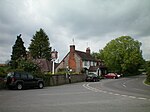Nore Folly
Nore Folly (also known as Slindon Folly) is a stone construction located near the village of Slindon, West Sussex, United Kingdom. The folly resembles a gateway but is a decorative piece which leads to nowhere. It was built of flint in the 18th century by the Newburgh family, possibly due to the countess's liking an Italian picture of a building.The National Trust, which restored the folly in 1993, states that Nore Folly was "built in 1814 for the Countess of Newburgh’s picnic parties". At that time there was a small covered building attached, which has since been torn down. It has been designated as a Grade II listed building.A well-used, although somewhat steep, walking path leads up to Nore Folly, at which there is an outlook with a clear view over the countryside, including a view of Halnaker Windmill, a long section of the coastline, Portsmouth Spinnaker Tower, Chichester Cathedral, and Bognor Regis.The folly has been featured on a first day cover designed by British First Day Covers Limited in 2006.
Excerpt from the Wikipedia article Nore Folly (License: CC BY-SA 3.0, Authors).Nore Folly
Nore Wood Lane, Arun
Geographical coordinates (GPS) Address External links Nearby Places Show on map
Geographical coordinates (GPS)
| Latitude | Longitude |
|---|---|
| N 50.87748 ° | E -0.64379 ° |
Address
Nore Hill Folly
Nore Wood Lane
BN18 0RJ Arun
England, United Kingdom
Open on Google Maps










